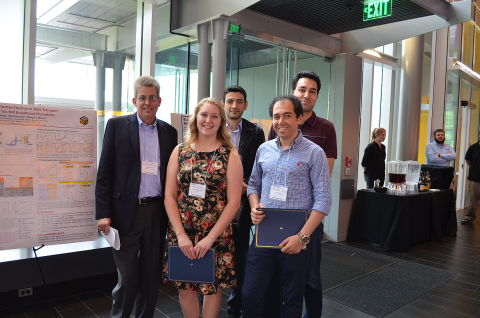On May 22nd and 23rd, 2017, IEN hosted its first annual “Technical Exchange Conference” to bring together academic and industry engineers working on global issues using interdisciplinary approaches. The event opened with the James D. Meindl Distinguished Lecture Series & Monie Ferst Award Symposium sponsored by Sigma Xi, to honor James D. Meindl, the founding director of the Nanotechnology Research Center, now IEN. Thee presentations from former students Vivek De (Intel Fellow, Intel Labs), Muhannad Bakir (Professor; School of Electrical and Computer Engineering, Georgia Institute of Technology) and Roger Howe (William E. Ayer Professor of Engineering; Faculty Director, Stanford Nanofabrication Facility) discussed the future of electronics as well as their perspectives on the contributions of Dr. Meindl.
The remainder of the events centered around the theme “Micro/Nano-Enabled Electronics for Global Challenges” and featured topical lecture sessions with prominent Georgia Tech faculty speakers, facility tours, and a student poster session.
IEN congratulates the four winners of the session for their excellent presentations.
Potentiometric Biosensing for Rapid, On-Site Disease Diagnostics - Eleanor Brightbill (MSE), Eleanor Brightbill graduated from the University of North Carolina at Chapel Hill with a B.S. in Chemistry before beginning her Ph.D. work in Materials Science and Engineering at Georgia Tech. As a member of the Vogel Lab, Eleanor is researching field-effect transistor-based potentiometric biosensing, specifically for serological disease detection.
Enabling the Next Generation of Ultrafast Integrated Optical Links - Amir Hosseinnia (ECE), Amir H. Hosseinnia is an ECE PhD candidate and research assistant with the Photonics Research Group (PRG) at Georgia Institute of Technology. During his PhD, he has been working on the design, fabrication and characterization of integrated nanophotonic devices, systems, and platforms. He has successfully developed various heterogeneous material platforms to realize ultra-low-loss, high-speed and high-efficiency integrated devices. His efforts to demonstrate high quality micro-resonators, high-efficiency interlayer couplers, and high-speed modulators on hybrid platforms has paved the path to realize the next generation of silicon photonic systems and devices, which he is working on.
His research interests include the design, optimization, and fabrication of integrated photonic devices, heterogenous optical platforms and novel optical materials. He also serves as the president of OSA Student Chapter at GT aimed to boost the science of optics through various events and conferences.
Ultra-Low Programming Voltage and Time Flash Memory Devices Using CVD Graphene - Ramy Nashed (ECE), Ramy Nashed received the B.Sc. degree in electronics engineering from Loughborough University, U.K., in 2010, and the M.Sc. degree in electronics engineering from American University in Cairo, Egypt, in 2013. He is currently pursuing the Ph.D. degree in electrical and computer engineering with Georgia Tech, USA. His research interests include the design, fabrication, and characterization of post-CMOS devices and interconnects. He recently joined Intel Corporation, Hillsboro, USA, as an Intern to study the reliability of the 14 nm-node FinFET transistors."
A Low Temperature Sacrificial Layer Based CMUT Fabrication Process for Improved Reliability - Amirabbas Pirouz (ECE), Amirabbas Pirouz was born in Amol, Mazandaran, Iran, in 1989. He received the B.S. degree in electrical engineering from University of Tehran, Tehran, Iran in 2012. He has completed an M.S. degree in 2015 and is continuing to pursue a Ph.D. degree in electrical engineering from the Georgia institute of Technology. His current research interests are in designing, modeling, fabricating, and characterizing capacitive micromachined ultrasound transducers (CMUTs) for catheter based CMUT imaging devices and especially intracardiac-echocardiography (ICE).
Additional Images
